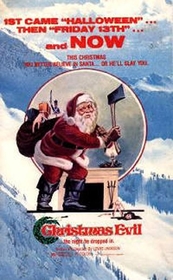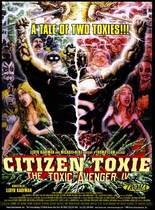Our editor-in-chief Nate Yapp is proud to have contributed to the new book Hidden Horror: A Celebration of 101 Underrated and Overlooked Fright Flicks, edited by Aaron Christensen. Another contributors include Anthony Timpone, B.J. Colangelo, Dave Alexander, Classic-Horror.com's own Robert C. Ring and John W. Bowen. Pick up a copy today from Amazon.com!
Christmas Evil (1980)
It’s Christmas Eve and tonight toymaker Harry Stadling (Brandon Maggart), with his homemade Santa suit and decrepit old van with a sleigh painted on the side, will deliver presents to a local hospital, stalk the neighborhood children that appear on his own “naughty” and “nice” lists, and kill a rich socialite in the middle of the street outside a church before the night is through. Though intriguing, the basic outline of Lewis Jackson’s Christmas Evil begs the question: Why does Harry do this?
For an answer, I looked to the opening scene again and again, and continually found even more questions. Said scene involves Harry as an eight-year-old boy, climbing down the stairs on Christmas Eve eager to disprove his brother Phillip’s claim that Santa Claus is just their father in disguise, only to discover that their mother is being kissed, groped, and fondled by Saint Nicolas himself. Is the man in the opening scene supposed to be the real St. Nick or is it just Harry’s father in disguise as Phillip suggested? Does this mean that Harry is mentally disturbed because he witnessed the vulnerability of his mother or because he knew his father was beneath the red garb and therefore his belief for Santa vanished at that moment? These arguments seem minor in the much larger scale of the rest of the film, but there’s nothing to suggest that either interpretation is the correct one and therefore, the audience is forced to simply accept the fact that this single event contains enough information to perpetuate the plot and provide suitable character development. It doesn’t.
There is too an unrequited tension between Harry and Phillip (Jeffrey DeMunn) that the film leads to but does little to build upon before reaching that point. Most of the interactions between the two brothers occur through phone messages where Phillip incessantly calls his brother to check on his mental state before the holidays; the two do not meet in person until a climatic showdown at the end of the film which carries little emotional significance to the audience because the two had such minor interactions prior. This moment between the two brothers should have held much more weight if we consider the opening scene once more, with Phillip inadvertently causing his brother’s emotional distress (whatever it might be). Instead, the film opts to put its emotional investment with the neighborhood children whom Harry stalk, which proves to be a mistake for two reasons: (1) the climatic finish does not involve them, so the conflict has no true feeling of resolution, and (2) the children in the film are terrible actors.
It seems wrong to criticize a child’s acting abilities but in a film that puts child actors in front of the camera as much as Christmas Evil does, a critique must be made because the end product noticeably suffers. In each scene where Harry interacts with one child or a group of children, there is a noticeable lack of conviction in the child actors’ faces and in their dialogue, which, considering even the adult actors suffer from the same fate, could be contributed to a lack of clear direction on the part of director Lewis. For nearly each character, child or adult, the dialogue is churned and spit out in a monotone droll that lacks conviction or emotion. There is no clear distinction between characters that are enthusiastic and upbeat and the ones that are depressed and in despair. It sounds as though each character is in constant despair, or fighting the urge to fall asleep.
However, this is not true of the outstanding lead. Maggart delivers a wild performance that is both haunting and exhilarating. His delivery is over-the-top at times, most noticeably in a scene where he delivers toys to a local children’s hospital and acts the part as Santa Claus, but at least it contains the conviction missing in the rest of the performances. Curious, however, is Maggart’s range. In one scene, he is telling children to be nice to their parents and be kind to the others, and we as an audience believe his sincerity. Compare this against an earlier scene where he is testing red fabric against his bent knees in anticipation of children sitting on his lap, and it’s hard to believe that there can still be room for sympathy, but there is. This is the work of a fine actor.
Yet even Maggart’s conviction in the lead role is not enough to put Christmas Evil on the top of anyone’s wish list. Its opening scene is a vague exposition that reveals the who, the what, and the when of the plot, but never explains why, and the finale is the end result of a neglected tension that holds no bearing with the audience emotionally. From reading online message boards, I’ve gathered that this movie has been deemed a “cult classic.” I would not go so far as to call it a cult classic, but it does contain a “cult performance,” one that is underestimated, underrated, and unforgettable.
This look at Christmas Evil is part of our Yuletide Terror event, a weekend of Christmas-themed reviews running December 21-25, 2007








